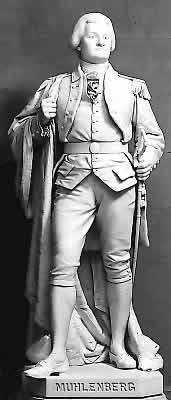Peter Muhlenberg | |
|---|---|
 | |
| United States Senator from Pennsylvania | |
| In office March 4, 1801 – June 30, 1801 | |
| Preceded by | William Bingham |
| Succeeded by | George Logan |
| Member of the U.S. House of Representatives from Pennsylvania's 4th district | |
| In office March 4, 1799 – March 4, 1801 | |
| Preceded by | John Chapman |
| Succeeded by | Isaac Van Horne |
| Member of the U.S. House of Representatives from Pennsylvania's at-large district | |
| In office March 4, 1793 – March 4, 1795 | |
| Preceded by | Constituency established |
| Succeeded by | Constituency abolished |
| In office March 4, 1789 – March 4, 1791 | |
| Preceded by | Constituency established |
| Succeeded by | Constituency abolished |
| 8th Vice-President of Pennsylvania | |
| In office October 31, 1787 – October 14, 1788 | |
| President | Benjamin Franklin |
| Preceded by | Charles Biddle |
| Succeeded by | David Redick |
| Personal details | |
| Born | John Peter Gabriel Muhlenberg October 1, 1746 Trappe, Pennsylvania, British America |
| Died | October 1, 1807 (aged 61) Grays Ferry, Philadelphia, Pennsylvania, U.S. |
| Political party | Democratic-Republican |
| Relations | Muhlenberg family Conrad Weiser (maternal grandfather) |
| Profession | Minister, Politician, Soldier |
| Signature | |
| Military service | |
| Allegiance | |
| Branch/service | |
| Years of service | 1776–1783 |
| Rank | |
| Commands | 8th Virginia Regiment |
| Battles/wars | |

John Peter Gabriel Muhlenberg (October 1, 1746 – October 1, 1807) was an American clergyman and military officer who served during the American Revolutionary War. A member of Pennsylvania's prominent Muhlenberg family political dynasty, he became a respected figure in the newly independent United States as a Lutheran minister and member of the United States House of Representatives and United States Senate.[1]
- ^ Kennedy, Will P. "Capital Sidelights." Washington, D.C.: The Sunday Star, October 11, 1942, p. 27 (subscription required).